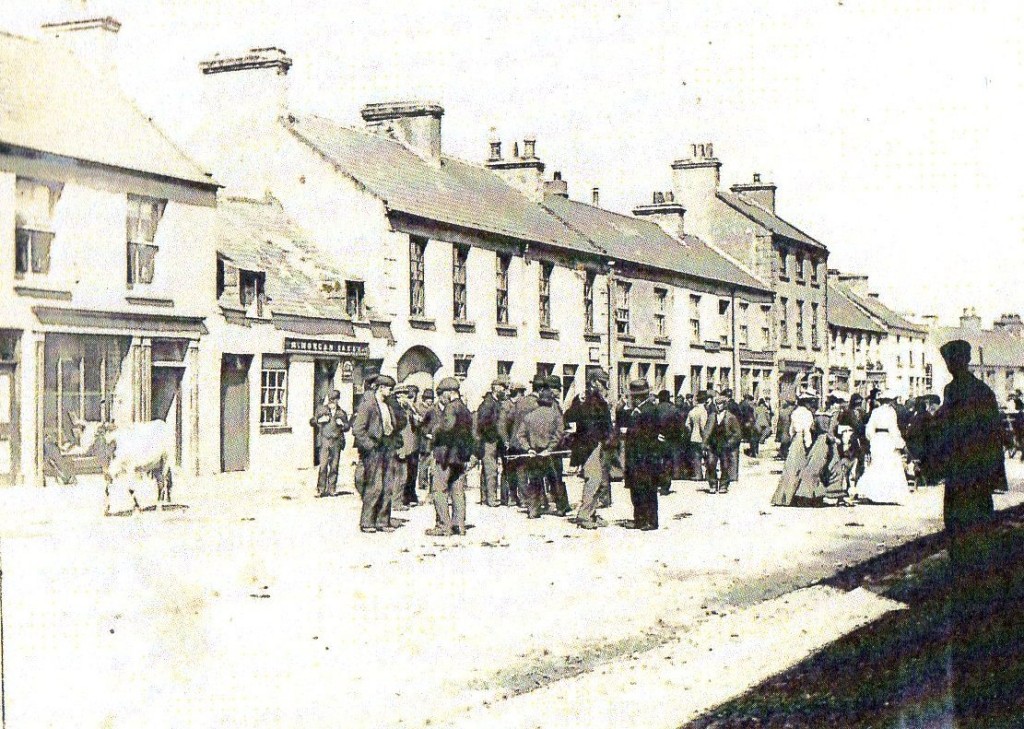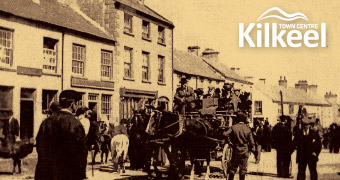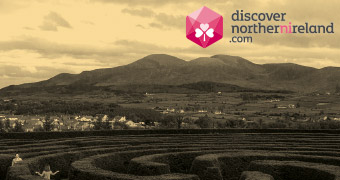Potatoes, potatoes, potatoes. Why was the potato grown and consumed on such a widespread scale in Ireland?
Potatoes were quite reliable and could produce a very good harvest (when not blighted). It was a vegetable which needed little care or attention when growing, so it was ideal for the majority of the population. The potato formed the basis of the Irish peoples diet, and could be used along with some diary produce such as milk. When the crop failed however, this caused major problems all over Ireland.
Other food stuffs such a oats, poultry and beef were in plentiful supply but these were expensive items and were shipped abroad by English landowners.
According to the report on the Kilmorey Estate by Octavius Knox, the main crops grown in the Mourne district by local farmers were potatoes, flax, oat and wheat. Potatoes would have been the principle meal for most people. An advantage of living in Mourne was it closeness to the sea. People would have benefited from this as they could live off the sea if need be, as well as the land.
Traditional foods such as Irish Stew were popular even in the 1800s. Praise for it was captured in this poem from the 1800s,
‘Then hurrah for an Irish Stew
That will stick to your belly like glue.’
Irish Soda Bread
In the early and mid 1800’s, rural Ireland did not have a strong tradition of bread made by using yeast. All baking was done in the home and, in addition to having limited baking supplies, time was often at a premium. The use of baking soda as a leavening agent was quick, effective and it produced a much more consistent result than yeast did. It caught on quickly and made soda breads a staple of the Irish diet until commercial bread production began. Irish soda bread is still popular with the Irish, as well as with people of other nationalities from all over the world.
The original soda breads contained nothing more than flour, buttermilk, baking soda and salt. The buttermilk was leftover from the butter making process and the bread was almost always served with freshly churned butter. Today, the bread often contain additional ingredients such as sugar, butter, currants or caraway seeds, to enhance the flavour of the bread. Soda bread is heartier than most yeast breads and goes very well with soups, stews and meat dishes. Modern soda bread mixes are available for those with a busy schedule and are easy to make with a delicious result.
Stirabout
Stirabout was a mixture, something almost like porridge. According to the Kilkeel Board of Guardians for the workhouse, they gave the inmates stirabout made from Indian meal and butter milk which was left over from the butter making process, therefore it was readily available and meant that nothing would be going to waste. This would have been a cheap meal, something which labourers/peasants would have eaten when potatoes were not available. It would have little flavour but it was still a meal.
Soup
Soup was a good, easily accessible and relatively cheap meal for most people. A farmer in Mourne would have had all the necessary ingredients due to being able to grow them himself on whatever land he had; potatoes, vegetables, barley etc. It was simple and easy to make, and if consumed with some homemade bread or soda bread, it would have been a filling and relatively taste meal. If you were lucky, there could have been some scraps of meal thrown in as well.
Shopping for Food
For those who did not have access to ingredients first hand from farming etc. there were many places in Kilkeel they could visit to acquire their daily essentials such as butchers, bakers, grocers etc. These stores would have been small and run by local people, nothing like the chains of supermarkets were are used to visiting today. Many stores would have had multiple uses, being a grocers and perhaps a bakery at the same time.
Below is a list of all the grocers in the Mourne area in 1870;
- Kilkeel: Thomas Baird, William Boyd, Neale Clarke, Arthur Crory, Robert Crutchley, Sarah Doyle, James Hagan, John Henderson, James McGinn, Moses Hill, George McKnight, Matthew Martin, Mary Minnis, James Morgan, Patrick Morgan, Ross Henry, Samuel Shannon, Maria Sloan, Samuel Woods.
- Ballymartin: William Annett, John Higgins.
- Ballygowan: James Cunningham.
- Annalong: John Gibney, James Robinson.
- Dunavan: James McCartney.
- Glassdrummond: Francis McGreevy.[1]
Here is a selection of the bakers present in 1870s Kilkeel;
Daniel Curran, James Doyle, James Hagan (who was also a grocer listed above and a spirit dealer), James McCartan, Thomas McKee, Matthew Martin, James Morgan, Henry Ross and Maria Sloan.
As you can see some of the bakers above overlap with the grocer section, demonstrating how some traders were taking on many different roles in order to supply the public with food stuffs.
This is a photo of Bridge Street. If you look closely at the left hand side of the street you can see Morgan’s Bakers. It is the building with the lowest roof.
Bradshaw’s General Directory of Kilkeel for 1819 lists Owen Feran and Francis Keirnan as butchers.[2]
Price of Food in the 1800s
In 1817, 12 stone of potatoes cost 6s6d and 7lb of meal cost 2s0d.[3]
In September 1846 the Board of Guardians were able buy a ton of oatmeal for £18.10.0 and a ton of indian meal for £13.0.0. The Board also advertised for tenders of supplying bread of a ‘coarse quality’ for the workhouse in 1846. They were received by Alexander Gordon, Matthew Martin and James Morgan. Gordon’s came in at 1&3/8 per lb and Martin’s at the same, whereas Morgan’s was priced at 1&1/2 per lb. [4]



